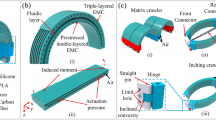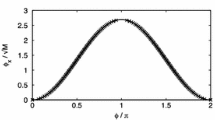Abstract
A novel mechanical device that is able to crawl inside tubes was designed and built. The device, which consists of at least one pair of right and left wound spring elements (twisted into a double helical structure) and an electric motor, propels itself in worm-like or snake-like fashion when actuated along a tube. A brief explanation of how the device is designed and assembled is given, as is a short description of its kinematics. The speed vectors and their application points and radii are also given, together with an analysis of the participation of the speed vectors and the sliding and rolling friction generated between the springs and the tube’s inner surface. The paper also covers the device’s possible nonlinear dynamic behavior when it moves inside a tube and provides some quantitative calculations, which take into account the effects of randomization in the considered phenomenon, even for cases of simple movement. With further development work, the model may be easily adapted to a variety of industrial and engineering applications.













Similar content being viewed by others
Notes
Note that in the previous case it was tangential to the outer tube.
Abbreviations
- A i :
-
Contact points between the spring and inner body
- c X , c Y , c Z , c x , c y , c z , c l :
-
Constant stiffness coefficients in the differential equations
- D :
-
Outer diameter of the double helical spring
- D i :
-
Inner diameter of the tube
- D b :
-
Bionic diameter of the device
- R 1, R 2 :
-
Friction coefficients static (resting) and dynamic (sliding)
- T :
-
Oscillation period
- d :
-
Diameter of the spring
- d i :
-
Diameter of the inner rod
- d 0 :
-
Diameter of the spiral line going through centers of the spring coils
- dm :
-
Differential of the mass
- F :
-
Driving slip friction force
- F roll :
-
Resistance of rolling friction force
- J x , J y , J z :
-
Moment of inertia of one turn of the spring, here J x = J y = J
- dJ :
-
Differential of the moment of inertia
- L :
-
Distance along the tube that the device has to travel
- M :
-
Inertial mass of the device
- l :
-
Stretching length of the spring
- m = M/n :
-
Inertial mass of one turn of the spring
- n :
-
Number of turns of the spring
- n s :
-
Number of secondary turns of the spring
- N :
-
Normal force between the tube or rod and spring
- P :
-
Elongation force acting on the spring at under particular conditions
- R 1, R 2 :
-
Static and dynamic friction coefficients
- S x :
-
Displacements along the axes
- T :
-
Kinetic energy
- Π:
-
Potential energy
- t 1 :
-
Average duration of the movement of the device
- t 2 :
-
Average duration of resting
- V average :
-
Average speed of the device
- V b, V, V 1, V 2 :
-
Bionic rolling speed, speed of the linearly moving device, tangential (or rolling) speed of rotation, rolling speed of the primary spring
- W :
-
General energy, work
- x i , y i , z i :
-
,Displacements in corresponding directions of the device at the i-step
- Ψ:
-
Twisting angle of the spring
- α:
-
Inclination angle of the tangent to the symmetry axes of the spring
- β:
-
Angle of the tangent to the movement trajectory
- γ:
-
Inclination angle of the sliding trajectory at the contact point of the inner rod
- λ:
-
Pitch of the spring’s wire, when wound, or pitch of the double helical spring
- μ, μroll :
-
Friction coefficient for sliding and rolling, respectively
- θ:
-
Rotation angle of the device
- ω:
-
Angular speed of the device around z axis
References
Chen, H.J., Gao, B.T., Zhang, X.H., Deng, Z.Q.: Drive control system for pipeline Crawl Robot based on CAN bus. J. Phys. Conf. Ser. 48, 1233–1237 (2006). doi:10.1088/1742-6596/48/1/229
Horodinca, M., Premount, A., Burda, I., Mignon, E.: The Heli-Pipe inspection Robots architecture for curved pipes, Universitatea Technica: Gh. Asachi. Iasi Tomul XLIX Supplement(LIII), (2003)
Panovko, J.G.: Foundations of Applied Theory of Elastic Oscillations [in Russian], 2nd edn. Mashinostroenie Publishers, Moscow (1967)
Pfeiffer, E., Rossman, T., Loffler, K.: Control of a tube crawling machine. In: Proc. Int. Conf. Control Oscillations Chaos, vol. 3, pp. 586–591. IEEE (2000)
Saga, N., Nakamura, T.: Development of a peristaltic crawling robot using magnetic fluid on the basis of locomotion mechanism of the earthworm. Smart Mater. Struct. 13, 566–569 (2004). doi:10.1088/0964-1726/13/3/016
Sandler, B.Z.: Numeralytics: a computation approach for practitioners. J. Mech. Des. 124(2), 151–157 (2002). doi:10.1115/1.1460903
Slatkin, A.B., Warren, J.B., Grundfest, W.: The development of a Robotic Endoscope. IEEE Trans. Robot. 2(5–9), 162–171 (1995)
Surpin, Y.: Spiral Propellers [in Russian], p. 3. Technica-molodezhi, Moscow (1972)
Surpin, Y.: Bionic propeller. In: Proc. 26th Israel Conf. on Mechanical Engineering, Technion, Haifa, 21–22 May 1996
Surpin, Y.: Bionic propeller. In: Proc. 27th Israel Conf. on Mechanical Engineering, Technion, Haifa, 19–20 May 1998
Surpin, Y.: Pure rolling elastic propelling device (PREP). In Proc. 29th Israel Conf. on Mechanical Engineering, Technion, Haifa, 12–13 May 2003
Acknowledgments
This work was supported by Paul Ivanier Center for Robotics and Production Management Research and the Pearlstone Center for Aeronautical Engineering Studies, Engineering Sciences Ben-Gurion University of the Negev, Beer-Sheva, Israel. Financial support for building the enlarged device was provided by one of Israel Industries. The authors thank the fourth year students M. Kling and H. Banja for their valuable input and assistance.
Author information
Authors and Affiliations
Corresponding author
Rights and permissions
About this article
Cite this article
Surpin, Y., Sandler, B. Elastic in tube propelling device (innovative design). Int J Mech Mater Des 5, 243–252 (2009). https://doi.org/10.1007/s10999-009-9098-2
Received:
Accepted:
Published:
Issue Date:
DOI: https://doi.org/10.1007/s10999-009-9098-2




